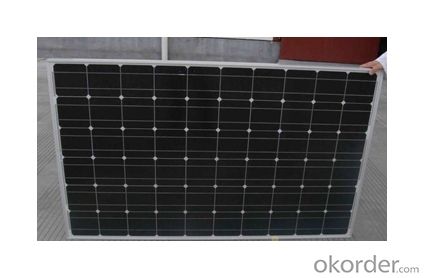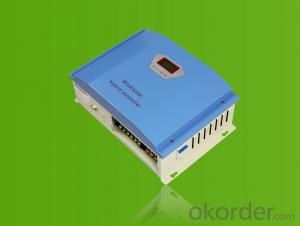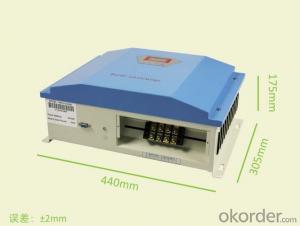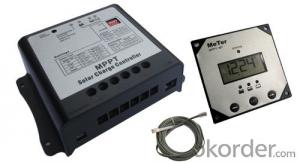Solar Charge Controllers for Mono-Crystalline 245W 125*125 Solar Modules
OKorder Service Pledge
OKorder Financial Service
You Might Also Like
Solar Module Descriptions:
A solar panel, or photovoltaic PV module, is a device that is composed of solar cells and which, when struck by photons of light from the sun, generates an electrical current which can then be used to power DC or AC electrical loads.



Electrical Characteristics
Max-power (W) | 245 |
Max-Power Voltage (V) | 50.5 |
Max-Power Current (A) | 4.85 |
Open-Circuit Voltage (V) | 61.1 |
Short-Circuit Current (A) | 5.35 |
Mechanical Characteristics
Cable type, Diameter and Length | 4mm2, TUV certified, 1000mm |
Type of Connector | Compatible with MC4 plug |
Arrangement of cells | 6*12 |
Cell Size | 125*125 |
Dimension | 1580*1069*45 |
Weight | 20.5Kg |
Glass, Type and Thickness | High Transmission, Low Iron, Tempered Glass 3.2mm |
Features
Guaranteed positive tolerance 0/+5w ensures power output reliability
Strong aluminum frames module can bear snow loads up to 5400Pa and wind loads up to 2400Pa.
Excellent performance under low light environments (mornings evenings and cloudy days)
12 years for product defects in materials and workmanship and 25 years for 80% of warranted minimum power.
Certifications and standards: IEC 61215.
Manufactured according to International Quality and Environment Management System (ISO9001, ISO14100).
FAQ
Q: What kind of loads can I run on PV?
With a correctly designed PV system you can power almost any electrical load. However, as the load size increases the expense also increases. Loads like hot water heaters, air conditioners, room heaters and electric stoves should be avoided. The added cost of trying to power loads like these is very cost prohibitive. If these loads have to be powered it will be a lot less expensive to change the appliance to use an alternative fuel type like propane.
Q: When do I need a charge controller and why?
The safest way to figure out if you need a charge controller is to take Battery Amp Hour Capacity and divide this by the Solar Panel max. power amp rating. If the quotient is above 200, you don't need a controller. If the number is less than 200 than you need a controller.
For example if you have a 100 amp hour battery and a 10 watt panel, you take 100 and divide it by .6 (600mA) and you get 166.6. Since this is less than 200 you need a charge controller. If you have a five-watt panel in the above example you take 100 divided by .3 (300mA) and you come up with 333.3. Since this is larger than 200 you do not need a charge controller. However you still need a blocking diode, to prevent the battery from discharging to the panel at night. So as a general rule of thumb you don't need a charge controller unless you have more than five watts of solar for every 100-amp hours of battery capacity.
Q: What is PV & how does it work?
PV stands for photovoltaic. Photo = Light and Voltaic = Electricity. A solar cell converts light to electricity.
A solar cell is made of silicon. Computer chips are made of this same material. Basically, when light strikes the surface of a solar cell some of it is absorbed into the silicon. This light energy bumps the electrons loose and causes energy to flow.
By packaging approximately 36 solar cells together a solar panel or a solar module is created. When you have more then one solar panels you create a solar array.
- Q: What is the communication protocol supported by a solar controller?
- The communication protocol supported by a solar controller is typically Modbus, which allows for data exchange and control between the solar controller and other devices in the solar power system.
- Q: Can a solar controller be used with solar panel sun tracking systems?
- Yes, a solar controller can be used with solar panel sun tracking systems. The solar controller is responsible for regulating the flow of electricity between the solar panels and the battery or grid. It ensures that the solar panels are operating at their maximum efficiency and that the batteries are charged properly. Therefore, it can be used in conjunction with sun tracking systems to optimize the performance and output of the solar panels.
- Q: Can a solar controller be used with solar panels that are connected to a solar lighting system?
- Using a solar controller with solar panels connected to a solar lighting system is possible. A solar controller, also referred to as a charge controller, is a vital component of a solar power system. It regulates the flow of electrical energy between the solar panels, battery storage, and other devices. Its purpose is to prevent the batteries from being overcharged or over-discharged, which can result in damage and a shorter lifespan. In the context of a solar lighting system, the solar controller plays a crucial role in managing the charging and discharging cycles of the batteries. These batteries store the energy generated by the solar panels during the day. The solar controller ensures that the batteries are optimally charged from the solar panels and that the stored energy is efficiently utilized for lighting purposes during nighttime. By utilizing a solar controller, the efficiency and lifespan of the solar lighting system can be maximized. It achieves this by safeguarding the batteries against excessive voltage and current fluctuations. Some solar controllers also offer additional features, such as load control. This feature allows users to manage the power consumption of the lighting system, ultimately extending the battery life. Therefore, it is highly recommended to incorporate a solar controller into a solar lighting system that is connected to solar panels. This ensures proper and efficient operation of the system.
- Q: What are the temperature compensation features in a solar controller?
- Temperature compensation features in a solar controller are designed to ensure optimal performance and efficiency of the solar system, regardless of the ambient temperature. These features help to counteract the effects of temperature fluctuations, which can significantly impact the charging and discharging processes of the solar batteries. One of the main temperature compensation features is the ability to adjust the charging voltage based on the temperature. As the temperature increases, the voltage required to charge the batteries effectively decreases to prevent overcharging. Conversely, as the temperature decreases, the charging voltage needs to be increased to compensate for the reduced battery efficiency. Another important temperature compensation feature is the ability to adjust the load disconnect voltage based on temperature. This feature ensures that the batteries are not discharged excessively in extremely cold temperatures, which can lead to irreversible damage. By raising the load disconnect voltage in colder temperatures, the solar controller protects the batteries from being drained beyond safe levels. Furthermore, temperature compensation features can also include temperature sensors that measure the ambient temperature and relay this information to the controller. This allows the controller to continuously monitor the temperature and make real-time adjustments to the charging and discharging processes. Overall, the temperature compensation features in a solar controller play a crucial role in maintaining the performance and longevity of the solar system. By accurately adjusting the charging voltage and load disconnect voltage based on temperature, these features help to optimize the efficiency and reliability of the solar system in various weather conditions.
- Q: What is the meaning of the DC load above the solar controller?
- Solar power systems are generally DC storage, of course, there are grid-connected power generation, the output is AC, but this system is still relatively small in the country, especially for some small systems. If it is a solar street light system,
- Q: What is the maximum discharge voltage for a solar controller?
- The maximum discharge voltage for a solar controller typically depends on its design and specifications. However, it is generally recommended to keep the discharge voltage between 11.5 and 12.5 volts to prevent over-discharge and potential damage to the battery.
- Q: Can a solar controller be used with a solar-powered street light?
- Yes, a solar controller can be used with a solar-powered street light. A solar controller is an essential component of a solar-powered street light system as it regulates the power flow from the solar panel to the battery, preventing overcharging and extending the battery's lifespan. It also manages the lighting operation, controlling when the street light should turn on and off based on the battery's charge level. Overall, the solar controller plays a crucial role in optimizing the performance and efficiency of a solar-powered street light.
- Q: Can a solar controller be used with solar string inverters?
- Solar string inverters can be used in conjunction with solar controllers, also known as charge controllers. These controllers are responsible for regulating the charging and discharging of batteries in a solar power system, preventing overcharging and over-discharging and extending battery lifespan. On the other hand, solar string inverters are utilized to convert the direct current (DC) generated by solar panels into alternating current (AC) electricity. This AC electricity can be used to power household appliances or be fed into the grid. Although solar controllers are commonly used in off-grid or hybrid solar systems with battery storage, they can still be employed alongside solar string inverters. In such setups, the solar controller regulates battery charging, while the solar string inverter converts DC electricity from solar panels into AC electricity for immediate use or grid integration. The utilization of a solar controller with solar string inverters offers added control and protection to the battery storage system. This ensures optimal battery charging and safeguards against damage caused by overcharging or deep discharging.
- Q: Can a solar controller be used with solar panels of different technologies (monocrystalline, polycrystalline, thin-film)?
- Yes, a solar controller can be used with solar panels of different technologies such as monocrystalline, polycrystalline, and thin-film. The solar controller's primary function is to regulate the charging of the batteries and manage the flow of electricity from the solar panels. It does not depend on the specific technology of the solar panels, but rather on the voltage and current output of the panels. Therefore, as long as the solar panels are within the voltage and current range supported by the solar controller, they can be used together regardless of the technology.
- Q: Can a solar controller be used with a solar-powered event space?
- Yes, a solar controller can definitely be used with a solar-powered event space. A solar controller helps regulate and optimize the charging of batteries or other energy storage systems connected to solar panels. It ensures efficient and safe utilization of solar energy, managing the flow of power and preventing overcharging or damage to the batteries. Using a solar controller would be essential in maintaining a reliable and sustainable power supply for a solar-powered event space.
Send your message to us
Solar Charge Controllers for Mono-Crystalline 245W 125*125 Solar Modules
OKorder Service Pledge
OKorder Financial Service
Similar products
Hot products
Hot Searches
Related keywords

























